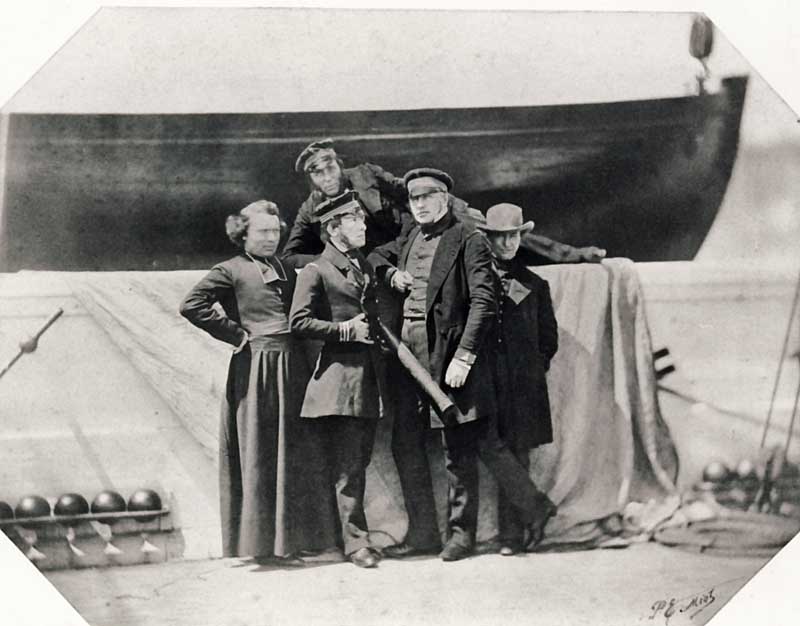![]()
Library and Archives Canada - Bibliothèque et Archives Canada PA-188215
Acquis avec le support financier du ministre du Patrimoine dans le cadre de la loi sur l'importation et l'exportation de biens culturels.
Acquired with the financial support of the Ministry of Heritage under the Cultural Property Export and Import Act.
![]()
"Photo prise à bord du Gassendi lors de la 20e réunion
de la Commission internationale des pêches, Saint-Jean, 16 août
1859." ["Photograph taken on board the Gassendi at the 20th meeting
of the International Fishery Commission, St. John's, 16 August 1859."]
 |
In 1859 there was an anglo-French diplomatic commission set up to look into disputes between the English and French over the French fishery in Newfoundland. Further information on this commission can be found in A Gentleman in the Outports: Gobineau in Newfoundland - see our bibliography.
The men above have been identified by the Library and Archives Canada as Captain Maurier, Captain de la Roncière, Lieutenant Jean-Philippe-Ernest de Fauque de Jonquières andPaulin Cl ément de Ris. What they were doing there is not immediately clear. The commissioners for that enquiry on the British side were Captain Dunlop of the Royal Navy and John Kent, Colonial Secretary in the Newfoundland government. On the French side were Captain Montaignac of the French navy and Count Gobineau, a diplomat. Each side had a secretary: Jenkinson for the British, Lossieux for the French. Camille Clément de la Roncière le Noury had been Commodore of the French naval station in Newfoundland in 1858, but in 1859 was replaced by Captain Montaignac and had been reassigned to naval actions in the Mediterranean. So this cannot be him. However, he had an elder brother, Émile François Guillaume de la Roncière le Noury. The latter had started a career in the army, but this came to an abrupt halt in 1834, when he was accused of raping the daughter of his commanding officer. He was found guilty, and sentenced to ten years in prison. But after eight years he was released, and in 1849 found to be completely innocent; the accusations against him were entirely fabricated. He then filled a series of administrative posts, and in May 1859 became Commandant of the French islands of St-Pierre & Miquelon. The presence of Clément de Ris is interesting: a friend of la Roncière's, he had been one of his defenders at the time the scandal broke out. He was a member of the French senate. The man on the left in clerical dress is no doubt the almoner of the Gassendi. Gobineau, in chapter 11 of his Voyage à Terre-Neuve relates how there had been a mass at the Basilica on 15 August with a significant contingent of British and French forces present in the capital for the enquiry. None of the subjects of this photograph directly involved in the enquiry, but it is entirely possible that they were present to provide advice to the French commissioners behind the scenes and for the ceremony at the Basilica. In fact, there was a deliberate attempt on the part of the French to repair relations between France and the Catholic bishop of St. John's, Mgr. Mullock, who had expressed vehement opposition to France on the occasion of the failed Labouchère convention of 1857.
En 1859 il y a eu une mission diplomatique anglo-française pour enquêter sur les disputes concernant la pêche française à Terre-Neuve. Pour de plus amples renseignements sur cette mission, voir A Gentleman in the Outports: Gobineau in Newfoundland, qui figure dans notre bibliographie.
Les hommes ci-dessus ont été identifiés par
les Archives nationales du Canada comme le capitaine de frégate Maurier,
le capitaine de vaisseau de la Roncière, le lieutenant de vaisseau
Jean-Philippe-Ernest de Fauque de Jonquières et Paulin Clément
de Ris. Ce
qu’ils y
faisaient n’est pas très clair. The commissaires du
côté britannique étaient le
capitaine Dunlop de la Royal Navy et John Kent, secrétaire
colonial du
gouvernement de Terre-Neuve. Du côté français il y
avait le capitaine
Montaignac de la marine française et le comte de Gobineau,
diplomate. Chaque
nation avait son secrétaire : Jenkinson pour les
Britanniques, et Lossieux
pour les Français. Camille Clément de la Roncière
le Noury avait commandé la
division navale de Terre-Neuve en 1858, mais en 1859 avait
été muté à des
actions navales dans la Méditerranée. Donc cela ne peut
être lui. Toutefois, il
avait un frère aîné, Émile François
Guillaume de la Roncière le Noury. Celui-ci
avait commencé une carrière dans l’armée,
carrière brusquement arrêtée en 1834,
quand il a été accusé d’avoir violé
la fille de son officier supérieur. Trouvé
coupable, il se voit condamné à dix ans de prison. Mais
au bout de huit ans il
a été libéré, puis, en 1849,
complètement réhabilité; les accusations
portées
contre lui avait été forgées de toutes
pièces. À ce moment-là il a commencé
à
remplir une séries de postes administratifs, et en mai 1859 se
voit nommé
commandant des îles françaises de St-Pierre-et-Miquelon.
La présence de Clément
de Ris est intéressante : ami de la Roncière, il
avait défendu celui-ci
lorsque le scandale a éclaté. Il était
sénateur en France. L’homme en tenu écclesiastique
a gauche est vraisemblablement l’aumonier du Gassendi. Dans le
chapitre 11 de
son Voyage à Terre-Neuve, Gobineau décrit une
messe célébrée à la basilique le 15 août avec une participation importante de forces
britanniques et françaises présentes dans la capitale pour l’enquête. Aucun des
sujets de cette photographie n’était directement impliqué dans cette enquête,
mais il est parfaitement possible qu’ils aient été présents pour donner des
conseils en coulisse, et aussi pour participer à la cérémonie à la basilique. Il
y a eu justement un effort délibéré de la part des Français de réparer les
rapports entre la Française et l’évêque catholique de St-Jean, Mgr. Mullock,
qui avait exprimé une opposition intransigeant à la France lors de la
convention Labouchère de 1857, convention qui n’a jamais abouti.
![]()